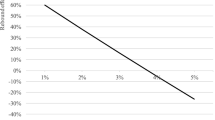Abstract
Limited supply of nonrenewable energy resources under growing energy demand creates a situation when a marginal change in the quantity supplied or demanded causes non-marginal swings in price levels. The situation is worsened by the fact that we are currently running out of cheap energy resources at the global scale while adaptation to climate change requires extra energy costs. It is often argued that technology and alternative energy will be a solution. However, alternative energy infrastructure also requires additional energy investments, which can further increase the gap between energy demand and supply. This paper presents an explorative model that demonstrates that a smooth transition from an oil-based economy to alternative energy sources is possible only if it is started well in advance while fossil resources are still abundant. Later the transition looks much more dramatic and it becomes risky to rely entirely on technological solutions. It becomes increasingly likely that in addition to technological solutions that can increase supply we will need to find ways to decrease demand and consumption. We further argue that market mechanisms can be just as powerful tools to curb demand as they have traditionally been for stimulating consumption. We observe that individuals who consume more energy resources benefit at the expense of those who consume less, effectively imposing price externalities on the latters. We suggest two transparent and flexible methods of pricing that attempt to eliminate price externalities on energy resources. Such pricing schemes stimulate less consumption and can smooth the transition to renewable energy.
Similar content being viewed by others
References
Arthur W B (2006). Out-of-equilibrium economics and agent-based modeling. In: Tesfatsion L, Judd K L eds. Handbook of Computational Economics Volume 2: Agent-Based Computational Economics. Amsterdam: Elsevier B.V., 1551–1564
Ayres R U, Ayres LW, Warr B (2003). Exergy, power and work in the US economy, 1900–1998. Energy, 28(3): 219–273
Bartusch C, Wallin F, Odlare M, Vassileva I, Wester L (2011). Introducing a demand-based electricity distribution tariff in the residential sector: demand response and customer perception. Energy Policy, 39(9): 5008–5025
Bhattacharyya S C (1996). Domestic energy pricing policies in developing countries: why are economic prescriptions shelved? Energy Sources, 18(8): 855–874
Brock WA, Xepapadeas A (2004). Management of interacting species: regulation under nonlinearities and hysteresis. Resour Energy Econ, 26(2): 137–156
Brookshire D S, Burness H S, Chermak J M, Krause K (2002). Western urban water demand. Nat Resour J, 2(4): 873–898
Cheshire P, Sheppard S (2005). The introduction of price signals into land use planning decision-making: a proposal. Urban Stud, 42(4): 647–663
Chow J, Kopp R J, Portney P R (2003). Energy resources and global development. Science, 302(5650): 1528–1531
Cleveland C J, Costanza R, Hall C A S, Kaufmann R (1984). Energy and the U.S. economy: a biophysical perspective. Science, 225(4665): 890–897
Costanza R, Hart M, Posner S, Talberth J (2009). Beyond GDP: the need for new measures of progress. The Pardee Papers 4: 46
Daly H, Farley J (2004). Ecological Economics.Washington D C: Island Press
Day J W Jr, Hall C A, Yanez-Arancibia A, Pimentel D, Marti C I, Mitsch W J (2009). Ecology in times of scarcity. Bioscience, 59(4): 321–331
Diamond J (2005). Collapse: How Societies Choose to Fail or Succeed. New York: Penguin, 1–576
Ehrlich P R, Ehrlich A H (2009). The Dominant Animal: Human Evolution and the Environment. Washington D C: Island press, 480 p
Ehrlich P R, Ehrlich A H (2013). Can a collapse of global civilization be avoided? Proceedings of the Royal Society B: Biological Sciences, 280(1754). http://rspb.royalsocietypublishing.org/cgi/doi/10.1098/rspb.2012.2845
EIA (2002). Annual Energy Review 2001. Energy Information Administration: DOE/EIA-0384, 432p
EIA (2013). Annual Energy Outlook 2013. US DOE, 244p
EIA (2013a). Short-term Energy Outlook. Release Date: August 6, 2013
Energy Information Administration. http://www.eia.gov/forecasts/steo/index.cfm
Ekins O, Folke C, De Groot R (2003). Identifying critical natural capital. Ecol Econ, 44(2–3): 159–163
El-Ashry M (2010). Renewables 2010 Global Status Report. Paris: REN21 Secretariat. Copyright Deutsche (GTZ) GmbH
Fader M, Gerten D, Krause M, Lucht W, Cramer W (2013). Spatial decoupling of agricultural production and consumption: quantifying dependences of countries on food imports due to domestic land and water constraints. Environmental Research Letters, 8(1): 014046. http://stacks.iop.org/1748-9326/8/i=1/a=014046?key=crossref.7dd1e79e39bbfb5d7423efaecb00e003
Farley J, Gaddis E (2007). An ecological economic assessment of restoration. In: Aronson J, Milton S, Blignaut J eds. Restoring Natural Capital: Science, Business and Practice. Washington DC: Island Press
Firrisa M T, van Duren I, Voinov A (2013). Energy Efficiency for Rapeseed Biodiesel Production in Different Farming Systems. Energy Efficiency, 1–17. http://link.springer.com/10.1007/s12053-013-9201-2
Gagnon L, Belanger C, Uchiyama Y (2002). Life-cycle assessment of electricity generation options: the status of research in year 2001. Energy Policy, 30(14): 1267–1278
Gever J (1986). Beyond Oil (3rd edition). New York: Harper Business
Goldin K D (1975). Price externalities influence public-policy. Public Choice, 23(1): 1–10
Gowdy J, Roxana J (2005). Technology and Petroleum Exhaustion: Evidence from Two Mega-Oilfields. Rensselaer Working Papers in Economics
Greene D L (1997). Oil dependence: the value of R&D. Proceedings of the Intersociety Energy Conversion Engineering Conference. Volume 3, 2148–2153
Greene D L, Hopson J L, Li J (2004). Running out of and into oil: analyzing global oil depletion and transition through 2050. Energy and Environmental Concerns, 2004(1880): 1–9
Gumilev L N (1990). Ethnogenesis and the Biosphere. Moscow: Progress Publishers
Hall C A S, Cleveland C J, Kaufmann R (1986). Energy and Resource Quality: The Ecology of the Economic Process. New York: John Wiley and Sons
Hall C A S, Day JW (2009). Revisiting the limits to growth after peak oil In the 1970s a rising world population and the finite resources available to support it were hot topics. Interest faded-but it’s time to take another look. Am Sci, 97(3): 230–237
Höök M, Hirsch R, Aleklett K (2009). Giant oil field decline rates and their influence on world oil production. Energy Policy, 37(6): 2262–2272. Available at: http://linkinghub.elsevier.com/retrieve/pii/S0301421509001281
Hubbert M K (1950). Energy from fossil fuels. Washington D C, American Association for the Advancement of Science Centennial: 171–177
Hughes J D (2013). Energy: a reality check on the shale revolution. Nature, 494(7437): 307–8. http://www.ncbi.nlm.nih.gov/pubmed/23426309
IEA (2007). Medium-Term Oil Market Report. Eagles L ed, International Energy Agency: http://omrpublic.iea.org/currentissues/mtomr2007.pdf
IEA (2011). World Enegy Outlook. In IEA, 666
Irastorza V (2005). New metering enables simplified and more efficient rate structures. Electr J, 18(10): 53–61
Kahl C H (2006). States, Scarcity, Civil Strife in the Developing World. Princeton, NJ and Oxford: Princeton University Press
Kenney D S, Goemans C, Klein R, Lowrey J, Reidy K (2008). Residential water demand management: lessons from Aurora, Colorado. J Am Water Resour Assoc, 44(1): 192–207
Kerr R A (2008). Energy. World oil crunch looming? Science, 322(5905): 1178–1179
Krugman P R (1979). Increasing returns, monopolistic competition, and international-trade. J Int Econ, 9(4): 469–479
Kubiszewski I, Cleveland C J, Endres P K (2008). Energy return on investment (EROI) for wind energy. In: Cleveland C J ed. Encyclopedia of Earth. last updated June 18, 2008
Levermann A, Clark P U, Marzeion B, Milne G A, Pollard D, Radic V, Robinson A (2013). The multimillennial sea-level commitment of global warming. Proceedings of the National Academy of Sciences (July 15): 1–6. http://www.pnas.org/cgi/doi/10.1073/pnas.1219414110
Lipsey R G, Courant P N, Purvis D D, Steiner P O (1993). Microeconomics (10th Edition). New York: Harper Collins College Publishers Inc
Loaiciga H A, Renehan S (1997). Municipal water use and water rates driven by severe drought: a case study. J AmWater Resour Assoc, 33(6): 1313–1326
Malthus T R (1826). An Essay on the Principle of Population. London: John Murray. Library of Economics and Liberty [Online] available from http://www.econlib.org/library/Malthus/malPlong1.html; accessed 18 May 2009
Meinshausen M, Meinshausen N, Hare W, Raper S C B, Frieler K, Knutti R, Frame D J, Allen M R (2009). Greenhouse-gas Emission Targets for Limiting Global Warming to 2 °C. Nature, 458(7242): 1158–1162
Mulder K, Hagens N J (2008). Energy return on investment: toward a consistent framework. AMBIO: A Journal of the Human Environment, 37(2): 74–79
Munasinghe M, Meier P (1993). Energy Policy Analysis and Modeling. Cambridge: Cambridge University Press
Murphy D J, Hall C, Powers B (2010). New perspectives on the energy return on (energy) investment (EROI) of corn ethanol. Environment, Development and Sustainability, 13(1): 179–202. http://link.springer.com/10.1007/s10668-010-9255-7
Murray J, King D (2012). Climate policy: oil’s tipping point has passed. Nature, 481(7382): 433–435
Pachauri R K, Reisinger A (2007). Climate Change 2007: Synthesis Report. Geneva, Switzerland, IPCC
Rees W E, Wackernagel M, Testemale P (1998). Our Ecological Footprint: Reducing Human Impact on the Earth. Gabriola Island: New Society Publishers
Simon J L (1998). The Ultimate Resource II. Princeton: Princeton University Press
Solomon S, Plattner G K, Knutti R, Friedlingstein P (2009). Irreversible climate change due to carbon dioxide emissions. Proc Natl Acad Sci USA, 106(6): 1704–1709
Stern N (2008). The Economics of Climate Change: The Stern Review. Cambridge: Cambridge University Press
Trewavas A (2002). Malthus foiled again and again. Nature, 418(6898): 668–670
Voinov A (2008). Systems Science and Modeling for Ecological Economics. Elsevier, Academic Press
Whitcomb J B. (2005). Florida water rates evaluation of single-family homes. Report to South Florida Water Management District: 113
Author information
Authors and Affiliations
Corresponding author
Rights and permissions
About this article
Cite this article
Voinov, A., Filatova, T. Pricing strategies in inelastic energy markets: can we use less if we can’t extract more?. Front. Earth Sci. 8, 3–17 (2014). https://doi.org/10.1007/s11707-013-0410-y
Received:
Accepted:
Published:
Issue Date:
DOI: https://doi.org/10.1007/s11707-013-0410-y




